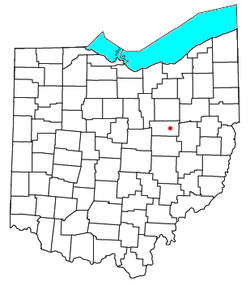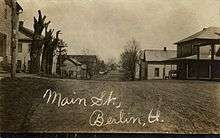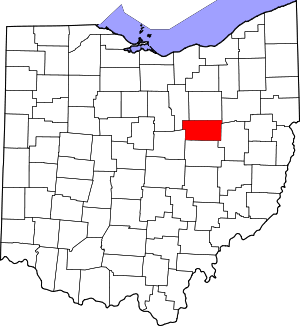Berlin, Holmes County, Ohio
Berlin is an unincorporated community and census-designated place (CDP) in central Berlin Township, Holmes County, Ohio, United States.[1] As of the 2010 census it had a population of 898.[2]
Berlin, Holmes County, Ohio | |
|---|---|
 Location of Berlin, Ohio | |
| Coordinates: 40°33′40″N 81°47′40″W | |
| Country | United States |
| State | Ohio |
| County | Holmes |
| Township | Berlin |
| Area | |
| • Total | 1.4 sq mi (3.7 km2) |
| • Land | 1.4 sq mi (3.7 km2) |
| • Water | 0.0 sq mi (0.0 km2) |
| Elevation | 1,285 ft (392 m) |
| Population (2010) | |
| • Total | 898 |
| • Density | 636/sq mi (245.7/km2) |
| Time zone | UTC-5 (Eastern (EST)) |
| • Summer (DST) | UTC-4 (EDT) |
| ZIP code | 44610 |
| Area code(s) | 330 Exchange: 893 |
| FIPS code | 39-05816 |
| GNIS feature ID | 1048519 |

Geography
Berlin is situated in east-central Holmes County at the junction of U.S. Route 62 and State Route 39. US-62 leads northeast 11 miles (18 km) to Wilmot, and State Route 39 leads southeast 10 miles (16 km) to Sugarcreek. Together, the two highways lead west 7 miles (11 km) to Millersburg, the Holmes county seat.
Berlin is located at latitude 40° 33' 40" north and longitude 81° 47' 40" west. The ZIP code is 44610 and the FIPS place code is 05816. The elevation ranges from 1,200 to 1,280 feet (370 to 390 m) above sea level.
History
The village of Berlin - the oldest existing village in Holmes County - was first planned on July 2, 1816, by John Swigert, a native of Berlin, Germany. Swigert's plan provided for 108 lots to be arrayed along two streets, one north-south and the other east-west. Another early settler, Joseph Troyer, hailed from Berlin, Pennsylvania, and together Swigert and Troyer bestowed upon the new settlement the shared name of their respective home towns. Berlin is located at a high point in Holmes County, and local legend holds that Swigert chose the site because, thus situated, the town could be more readily defended against Indian attack.
A large share of the early settlers of the Berlin area were of German or Swiss ancestry and came to Ohio via Pennsylvania.
In 1818, a school was established in Berlin and in 1822 a post office.[3] These were soon followed by Methodist, Presbyterian, Baptist and Mennonite churches. Later, Amish settlers began to arrive. Berlin enjoyed commercial and industrial growth, and during the 19th century was home to machine shops, a foundry, blacksmith shops, a hat factory, hotels, an auction house, and a variety of retail establishments.[4] Berlin was described in 1833 as having 21 residential houses, two stores, two taverns and a physician.[5]
Today, Berlin is in the center of Ohio's largest Amish community. Ohio has about 56,000 Amish residents, an increase of 60 percent since 1992.[6]
Notable people
- Atlee Pomerene, U.S. senator
- Nate Torrence, television actor
- Alta Weiss, early semiprofessional female baseball player
See also
References
- U.S. Geological Survey Geographic Names Information System: Berlin, Holmes County, Ohio
- "Geographic Identifiers: 2010 Census Summary File 1 (G001): Berlin CDP, Ohio". American Factfinder. U.S. Census Bureau. Archived from the original on February 13, 2020. Retrieved January 9, 2018.
- Gallagher, John S. and Patera, Alan H. The Post Offices of Ohio. The Depot, 1979, p. 129.
- "Area History". Berlin Village Info. Berlin Main Street Merchants. Archived from the original on 2011-10-05. Retrieved 2011-10-07.
- Kilbourn, John (1833). The Ohio Gazetteer, Or a Topographical Dictionary. Scott and Wright. pp. 93. Retrieved 12 December 2013.
- Zachariah, Holly; Josh Jarman (23 August 2008). "Amish Population is Growing, Shifting". The Columbus Dispatch. Archived from the original on 2010-10-22. Retrieved 2008-10-25.
